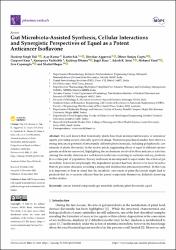Gut Microbiota-Assisted Synthesis, Cellular Interactions and Synergistic Perspectives of Equol as a Potent Anticancer Isoflavone

View/
Date
2022Author
Varol, MehmetTuli, Hardeep Singh
Kumar, Ajay
Sak, Katrin
Aggarwal, Diwakar
Gupta, Dhruv Sanjay
Çapanoğlu,Esra
Metadata
Show full item recordCitation
Tuli HS, Kumar A, Sak K, Aggarwal D, Gupta DS, Kaur G, Vashishth K, Dhama K, Kaur J, Saini AK, Varol M, Capanoglu E, Haque S. Gut Microbiota-Assisted Synthesis, Cellular Interactions and Synergistic Perspectives of Equol as a Potent Anticancer Isoflavone. Pharmaceuticals (Basel). 2022 Nov 16;15(11):1418. doi: 10.3390/ph15111418. PMID: 36422548; PMCID: PMC9697248.Abstract
It is well known that, historically, plants have been an important resource of anticancer agents, providing several clinically approved drugs. Numerous preclinical studies have shown a strong anticancer potential of structurally different phytochemicals, including polyphenolic constituents of plants, flavonoids. In this review article, suppressing effects of equol in different carcinogenesis models are unraveled, highlighting the mechanisms involved in these anticancer activities. Among flavonoids, daidzein is a well-known isoflavone occurring in soybeans and soy products. In a certain part of population, this soy isoflavone is decomposed to equol under the action of gut microflora. Somewhat surprisingly, this degradation product has been shown to be more bioactive than its precursor daidzein, revealing a strong and multifaceted anticancer potential. In this way, it is important to bear in mind that the metabolic conversion of plant flavonoids might lead to products that are even more efficient than the parent compounds themselves, definitely deserving further studies.

















